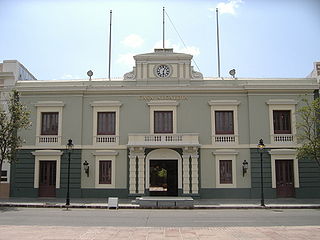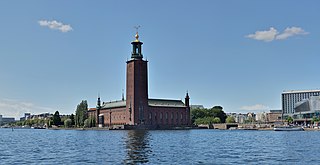
Gotland County is a county or län of Sweden. Gotland is located in the Baltic Sea to the east of Öland, and is the largest of Sweden's islands. Counties are usually sub-divided into municipalities, but Gotland County consists of only one county council, which also serves as a municipality, Region Gotland. Gotland County is the only county in Sweden that is not governed by a municipal council. The municipality handles the tasks that are otherwise handled by the county council: mainly health care and public transport. Like other counties, Gotland has a County Administrative Board, which oversees implementation of the Swedish state government. Both the County Administrative Board and the municipality have their seat in the largest city, Visby, with over 22,000 inhabitants. Princess Leonore, the daughter of Princess Madeleine, is Duchess of Gotland.

A municipality is usually a single administrative division having corporate status and powers of self-government or jurisdiction as granted by national and regional laws to which it is subordinate.
A county is a geographic region of a country used for administrative or other purposes in some nations. The term is derived from the Old French comté denoting a jurisdiction under the sovereignty of a count (earl) or, in his stead, a viscount (vicomte). Literal equivalents in other languages, derived from the equivalent of "count", are now seldom used officially, including comté, contea, contado, comtat, condado, Grafschaft, graafschap, and zhupa in Slavic languages; terms equivalent to 'commune' or 'community' are now often instead used.

Local government is a generic term for the lowest tiers of governance or public administration within a particular sovereign state.

Skåne County, sometimes referred to as Scania County in English, is the southernmost county, or län, of Sweden, mostly corresponding to the traditional province of Scania. It borders the counties of Halland, Kronoberg and Blekinge and connects to Capital Region, Denmark by the Öresund Bridge across the Øresund strait. The seat of residence for the Skåne Governor is the city of Malmö. The headquarters of Skåne Regional Council are located in both Kristianstad and Malmö.

Västra Götaland County is a county or län on the western coast of Sweden.

Stockholm County is a county on the Baltic Sea coast of Sweden. It borders Uppsala County and Södermanland County. It also borders Mälaren and the Baltic Sea. The city of Stockholm is the capital of Sweden. Stockholm County is divided by the historic provinces of Uppland (Roslagen) and Södermanland (Södertörn). More than one fifth of the Swedish population lives in the county. Stockholm County is also one of the statistical riksområden according to NUTS:SE, Nomenclature of Territorial Units for Statistics within the EU. With more than two million inhabitants, Stockholm is the most densely populated county of Sweden.

Jönköping County is a county or län in southern Sweden. It borders the counties of Halland, Västra Götaland, Östergötland, Kalmar and Kronoberg. The total county population was 356,291 inhabitants in September 2017. The capital and largest city is Jönköping. About one quarter of the total county population lives in the combined Jönköping-Huskvarna urban area around the southern point of Lake Vättern.

Södermanland County is a county or län on the southeast coast of Sweden. In the local Sörmlandic dialects it is virtually universally shortened and pronounced as Sörmlands län, or simply Sörmland, which is the dominant pronunciation and spelling inside the county. For example, the name of the local regional council is Region Sörmland. Södermanland's capital is Nyköping and the largest settlement is Eskilstuna. In the sparsely populated interior, Katrineholm is the largest locality. In total, Södermanland has nine municipalities and about 300,000 inhabitants.

Devolution is the statutory delegation of powers from the central government of a sovereign state to govern at a subnational level, such as a regional or local level. It is a form of administrative decentralization. Devolved territories have the power to make legislation relevant to the area, thus granting them a higher level of autonomy.

The counties of Sweden are the first-level administrative subdivisions of Sweden. There are twenty-one counties; however, the number of counties has varied over time, due to territorial changes and to divisions and/or mergers of existing existing counties.

Halland County is a county (län) on the western coast of Sweden. It corresponds roughly to the cultural and historical province of Halland. The capital is Halmstad. Prince Julian, the son of Prince Carl Philip, is Duke of Halland.

Region Gotland, legally Gotlands kommun, is a municipality with regional responsibilities that covers the entire island of Gotland in Sweden. The city of Visby is the municipality's seat. Gotland Municipality is the 39th most populous municipality in Sweden.

Region Stockholm is the regional public body responsible for healthcare, public transport, and regional planning within Stockholm County, Sweden. Established on 1 January 2019, it replaced the former Stockholm County Council as part of a nationwide reform.
Region Skåne is the regional council of Skåne County in Scania, Sweden. Region Skåne was formed on 1 January 1999 by the amalgamation of the county councils of Malmöhus County and Kristianstad County and some of the tasks handled by Malmö Municipality.

Stockholm Municipality or the City of Stockholm is a municipality in Stockholm County in east central Sweden. It has the largest population of the 290 municipalities of the country, but one of the smallest areas, making it the second most densely populated. It is also the most populous municipality in the Nordic countries.
The Philippines is divided into four levels of administrative divisions, with the lower three being defined in the Local Government Code of 1991 as local government units (LGUs). They are, from the highest to the lowest:
- Regions are mostly used to organize national services. Of the 17 regions, only one—the Bangsamoro Autonomous Region in Muslim Mindanao—has an elected government to which the central government has devolved competencies.
- Provinces, independent cities, and one independent municipality (Pateros)
- Component cities and municipalities within a province
- Barangays within a city or municipality

The regions of England, formerly known as the government office regions, are the highest tier of sub-national division in England. They were established in 1994 and follow the 1974–96 county borders. They are a continuation of the former 1940s standard regions which followed the 1889–1974 administrative county borders. Between 1994 and 2011, all nine regions had partly devolved functions; they no longer fulfil this role, continuing to be used for limited statistical purposes.

The military subdivisions of Sweden refers to the division of Sweden's territory with regard to the command possibilities, mainly in war. The subdivisions are different depending on Sweden's military doctrine. The subdivision can apply to both land and sea territory. On 1 January 2013, the Swedish Armed Forces re-established regional staffs, dividing the country into four military regions. A fifth military region was formed in 2019.
The Central Military Region is a Swedish military region within the Swedish Armed Forces. Established in 2013, the military region staff in based in Kungsängen. The military region includes Dalarna County, Gotland County, Gävleborg County, Stockholm County, Södermanland County, Uppsala County and Västmanland County.















